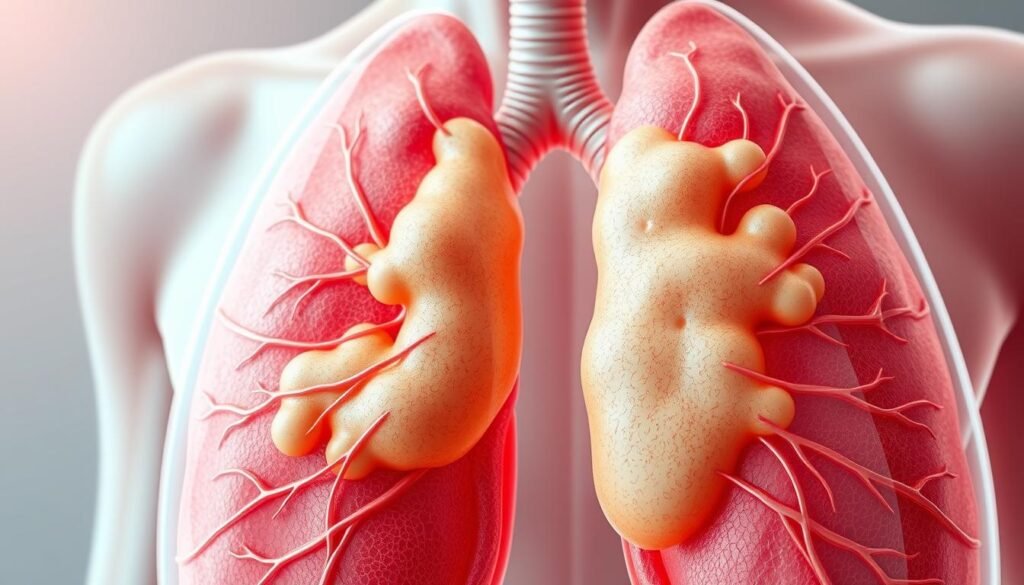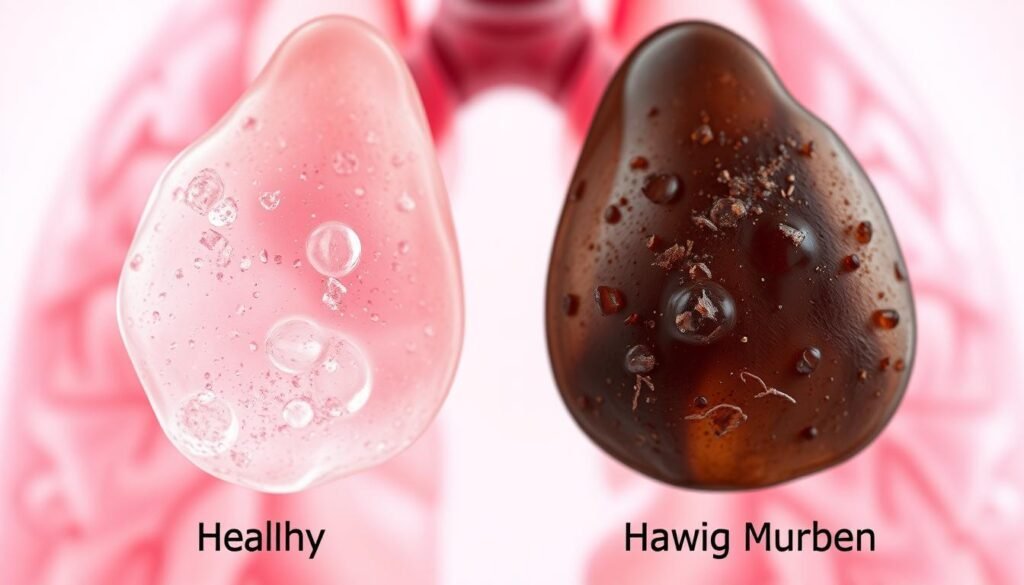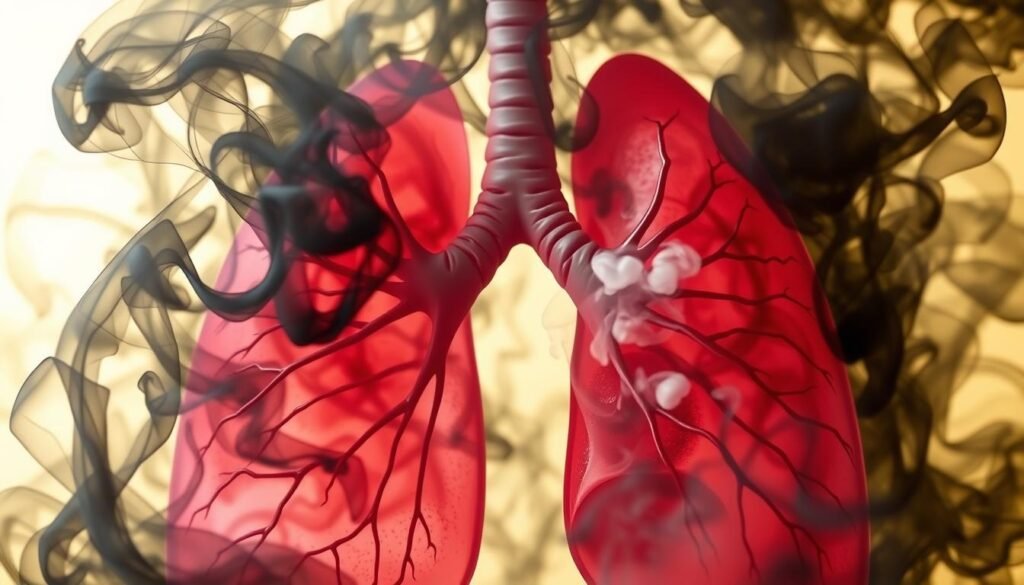Lung cancer is the top cause of cancer deaths worldwide, accounting for about 1 in 5 cancer deaths. Many people don’t know about the early signs that point to this disease. One such sign is unusual phlegm linked to lung cancer.
Early symptoms are often not clear, leading to missed warnings like odd changes in lung cancer phlegm. Spotting these signs, such as constant coughing, phlegm changes, and bloody sputum, is key. Realizing them early can make treatments work better. So, it’s important to watch for any body changes, especially in mucus production in the lungs.
Key Takeaways
- Lung cancer often shows minimal symptoms until it has progressed.
- Key symptoms include persistent cough, coughing up blood, and unexplained weight loss.
- Early detection significantly improves treatment outcomes for lung cancer.
- Being aware of changes in phlegm can indicate potential lung health issues.
- Consulting a medical professional upon noticing warning signs is crucial.
What is Lung Cancer?
Lung cancer begins when abnormal cells grow in the lungs. This illness is the top cause of cancer deaths worldwide. It can affect anyone, whether they smoke or not, which makes it important for all of us to know its risks. Lung cancer comes in two main types: small cell and non-small cell. They look different under a microscope and need different treatments.
Knowing the type of lung cancer is crucial for choosing the best treatment. Many people with lung cancer have a cough that won’t go away, pain in the chest, or trouble breathing. These symptoms often don’t show up until later, which is why it’s so important to catch the disease early. Studies show that finding lung cancer early can lead to better chances of success in treatment. There’s a special screening for those at high risk. For more info on symptoms and how to get screened, visit lung cancer symptoms and screening options.
Understanding the Role of Phlegm in Lung Health
Phlegm plays a key role in keeping our lungs healthy. It protects the respiratory system from irritants and germs. It’s important to know what phlegm does and when its production is not normal.
Defining Phlegm and Its Functions
Phlegm is a sticky fluid your lungs make. It consists of water, salts, and immune cells. It catches dust and germs to stop them from reaching the lungs. Phlegm keeps the lungs moist, protects the airways, and helps in breathing smoothly.
Normal vs. Abnormal Phlegm Production
Usually, mucus is clear and thin. It changes based on health and environment. But if phlegm changes in color or thickness, it could mean something’s wrong. Green or yellow could mean bacterial infections. Red or brown could point to blood, a sign of serious issues.
The following table highlights key differences between normal and abnormal phlegm characteristics:
| Characteristic | Normal Phlegm | Abnormal Phlegm |
|---|---|---|
| Color | Clear or thin | Green, yellow, red, or brown |
| Consistency | Thin and watery | Thick and sticky or frothy |
| Associated Symptoms | None | Fever, chest pain, or worsening cough |
| Medical Attention Required | No | Yes, especially if persistent |
Chronic conditions like asthma or COPD might cause more mucus. Any change in this mucus should be checked by a doctor. Drinking plenty of fluids and using humidifiers can help manage this, keeping breathing easier.

Common Symptoms of Lung Cancer
Lung cancer might not be noticeable until it’s pretty serious. So, knowing what symptoms to look for is key. Catching lung cancer early can make treatment more effective. Let’s look at what symptoms to watch out for, both early on and later.
Early Symptoms to Watch For
Early lung cancer signs are often not obvious but include:
- Persistent cough: A cough that lasts more than two months and gets worse.
- Unexplained weight loss: Losing weight quickly without trying is a sign to watch.
- Fatigue: Feeling tired all the time, even with plenty of rest, could mean something’s wrong.
Spotting these early signs is crucial. Catching cancer sooner can mean better treatment options. For deep dives into lung cancer symptoms, check out common signs of advanced lung cancer.
Advanced Symptoms Indicating Potential Lung Cancer
When lung cancer gets worse, the symptoms are clearer. Here’s what may happen:
- Increased chest pain: Any new or sharp pain in the chest is a red flag.
- Worsening cough: If the cough gets nastier, including blood or rust-colored spit, it’s time to worry.
- Difficulty breathing: Struggling to breathe or wheezing a lot affects life quality.
Seeing these advanced symptoms means urgent action is needed. Screening is vital for people at high risk, like smokers. Being alert and seeing a doctor early can help manage lung cancer.
Lung Cancer Phlegm: Key Warning Signs
Getting to know the signs of lung cancer phlegm is crucial. One major sign is finding blood in your phlegm, a condition called hemoptysis. Spotting this early can lead to quick action for your health.
Coughing Up Blood or Rust-Colored Sputum
Coughing up blood signals major health concerns. This might look like blood streaks in your phlegm or a rust color. These symptoms could mean lung infections or even cancer. It’s important to talk to a doctor fast if you’re coughing up blood. Early detection improves chances of successful treatment. For extra info, check out this resource.
Changes in Consistency and Color of Phlegm
Watching for changes in your phlegm can reveal a lot about lung health. Normally, phlegm is clear or white. But, any other colors might show problems like lung cancer or infections. If your phlegm changes color or gets thicker, see a doctor. Signs like this should not be ignored and require quick attention.

| Symptom | Possible Cause | Importance of Evaluation |
|---|---|---|
| Coughing up blood | Lung cancer, infection | Warrants immediate medical consultation |
| Changes in phlegm color | Lung disease, infection | Indicates a need for medical assessment |
| Chronic mucus production | Lung disease | Signs of deteriorating lung health |
| Chronic cough | Potential lung cancer | Suggests a serious respiratory issue |
The Impact of Coughing on Lung Health
Coughing helps clear our lungs from stuff that shouldn’t be there. But a chronic cough is more than annoying. It could be a sign of serious health problems, like lung cancer. A study found that 65% of people diagnosed with lung cancer had a nagging cough. And it gets worse as the disease progresses. Over 80% of those with advanced lung cancer have a constant cough.
When a cough lasts more than eight weeks, it could be a lung cancer cough. Such a cough can hurt your lung health. Though only 2% of long-lasting coughs are due to lung cancer, it’s important to know the signs. For those not treated for lung cancer, 54% reported coughing. This compares to 40% of those who were getting treatment. These facts remind us of the need to pay attention to coughing.
Not paying mind to a chronic cough can lead to a late diagnosis. This may limit treatment options and worsen the outcome. Catching lung cancer early can greatly improve chances of surviving. For example, people with early-stage non-small-cell lung cancer have a survival rate of 63%. This rate drops as the cancer spreads. So, noticing and acting on a persistent cough is key. It might be the first sign of lung cancer, helping get the right treatment early.

Causes of Phlegm Production in Lung Cancer
It’s important to know why phlegm production increases in lung cancer. Phlegm, also called mucus, grows due to irritants in the lungs. Things like pollution, infections, and the cancer itself are common causes. Lung cancer changes how much mucus is made, leading to more phlegm.
Different lung cancers can make more mucus. For example, a type called Invasive mucinous adenocarcinomas (IMAs) often leads to bronchorrhea. This condition means making more than 100 mL of watery sputum every day. IMAs are rare, but they show why knowing about this link is key for doctors.
Several outside factors also make phlegm worse in lung cancer patients. Smoking and working with harmful chemicals can make you more likely to get lung cancer. This, in turn, raises mucus production. Those who have had chest radiation might also make more phlegm. Understanding these causes can help spot symptoms early and get the right help.
- Environmental pollutants
- Infections such as pneumonia or bronchitis
- Types of lung cancer, including IMAs
- Smoking and exposure to carcinogens
- History of radiation therapy
These factors highlight how lung cancer and mucus production are linked. They affect how patients feel and need proper treatment.
When to Seek Medical Attention
Knowing when to get medical help can really change the outcome for those with signs of lung cancer. It’s vital to know about urgent lung cancer symptoms for quick action.
Recognizing Urgent Symptoms
A persistent cough, chest pain, and coughing up blood are major signs to look for. Spotting these symptoms early can lead to necessary tests. Acting fast improves chances for an early find, which is key for better treatment options.
The Importance of Early Diagnosis
Finding lung cancer early is key. A lot of cases aren’t found until they’re advanced. Going for regular check-ups and watching for any symptoms helps raise survival chances. It’s important to stay alert and see a doctor if something seems wrong. Knowing and acting on any symptoms is crucial for good health. For more on spotting symptoms, check out this resource.
Understanding Hemoptysis: Coughing Up Blood
Hemoptysis means coughing up blood and it’s a sign that needs quick attention. It often indicates severe health problems, like lung cancer symptoms. Besides lung cancer, it could also mean chronic bronchitis, pneumonia, or metastatic cancer. About 20 percent of people with lung cancer may cough up blood, especially in late stages.
The severity of hemoptysis can range from minor to major bleeding. Severe cases, up to 82 percent, are often linked to small cell lung cancer (SCLC). Those with non-small cell lung cancer may also experience it. It’s important to watch for any changes. If coughing up blood without a known reason, especially if it’s a lot or with other bad symptoms, tell a healthcare professional.
Teaching people about hemoptysis can help find lung cancer and other conditions early. Sadly, only 23 percent of lung cancer cases are found early. Raising awareness could help more people survive. If you cough up blood, see a doctor right away for a thorough check-up and proper treatment.